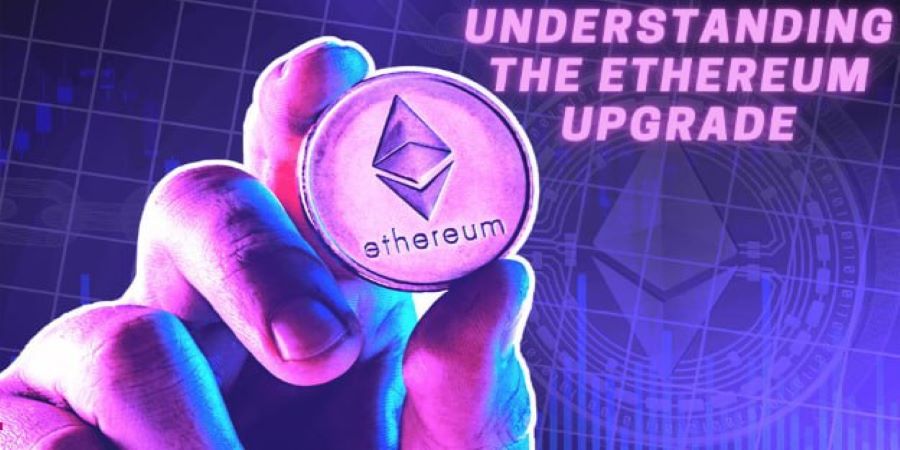When Ethereum originally began laying the framework for a new era of decentralized capabilities, it drew users in with its built-in support for smart contracts and applications that ran on a decentralized network (DApps).
However, its use by millions of people requires a significant amount of energy and has resulted in excessively high gas fees, persistent network congestion, lengthy transaction confirmations, and massive blockchain size–problems that are not unusual with the proof of work consensus mechanism that Ethereum uses.
The most significant update in the history of Ethereum was completed on 15 September, 2022, and industry analysts are calling it a “game changer” for the whole cryptocurrency market.
All indications, as of this point, point to the fact that the so-called merging, which is intended to reduce the cryptocurrency’s energy use by more than 99%, was successful.
But what exactly is “Ethereum 2.0” all about?
WHAT IS ‘ETHEREUM 2.0’?
Initially, the developers of Ethereum referred to the ETH upgrade as Ethereum 2.0 or Eth2. However, sometime in January 2022, they discarded the use of these coined terms due to widespread confusion amongst Crypto faithful. The words “consensus layer” and “execution layer” are now more commonly used to refer to Ethereum’s new upgrade.
The upgrade will hopefully improve the speed, efficiency, and scalability of the Ethereum network, allowing it to avoid congestion and handle a greater number of transactions at the same time. The rebranding is designed to convey the fact that what is actually taking place is an upgrade to the existing network rather than the creation of an entirely new network.
Now, as a result of the upgrade, Ethereum has transitioned to a protocol known as Proof-of-Stake, which replaces miners with validators in the blockchain. Instead of running enormous banks of computers, validators use their preexisting caches of Ether as a mechanism to validate transactions and mint new tokens.
This reduces the amount of energy required to do these tasks. Experts believe that this will make the protocol more secure while also making it more sustainable because it uses a significantly lower amount of power than mining does.
DIFFERENCE BETWEEN PROOF-OF-STAKE AND PROOF-OF-WORK.
Proof-of-Work (PoW) is the protocol that the Ethereum network previously ran on. This protocol consists of miners, who are frequently organized into groups known as mining pools, competing with one another to solve difficult mathematical problems.
Miners compete against one another to determine a hash. Ultimately, the person who discovers this correct hash first will be the one to receive the benefit of the specific blockchain’s token and updating the blockchain with the newly confirmed transactions.
PoW is a tried and tested way of reaching consensus, but as blockchain networks grow in size, the process has become increasingly unworkable and demanding of a lot of energy. The transaction volume that can be generated by networks compatible with smart contracts, such as Ethereum, can be enormous. It takes an enormous amount of computational power to validate these transactions using PoW.
This problem is solved by Proof-of-Stake (PoS), which replaces mining with a staking mechanism and requires validators to stake, or deposit as collateral, a certain amount of the chain’s token in order to qualify as a validator in the network. PoS consumes a lesser amount of processing power. This is because, instead of all validators vying against one another simultaneously, a single validator is selected at random.
When a validator is selected, they are granted the permission to add new blocks to the blockchain. Following this, the information added to the blockchain is subjected to an attestation process in which it is verified by the other members of the network. In exchange, validators are awarded the native token of that blockchain.
One is required to stake a minimum of 32 ETH in order to operate a validator node on the updated version of Ethereum.
WHAT IS THE EFFECT OF THE UPGRADE ON ETHEREUM’S SECURITY, SCALABILITY AND SUSTAINABILITY?
- On Security, PoS encourages more decentralization.
The amount of required hardware will be reduced, which will make it easier for more nodes to join the network and reduce the entry barrier. Ethereum will thus have a minimum of 16,384 validators now that the upgrade has gone live.
The implementation of PoS further reduces the incentive to launch any future attacks. To begin, if validators make an attack effort, the protocol has the potential to ‘slash’, which means it will destroy any ETH that has been staked by those validators.
Further, in order to carry out an attack (like a 51% attack or a Sybil attack), the hackers will now need to own at least 51% of the ETH that has been staked rather than having control over 51% of the network’s mining power. Not only is this sum impossible to pay (about $15 billion USD as of right now), but it is also quite likely to result in a major devaluation of ETH, which would dissuade an attack of this kind.
- On Scalability, in addition to the positive effects on energy consumption, Proof of Stake will substantially increase Ethereum’s capacity.
Prior to the upgrade, the Ethereum network was only capable of supporting 15 transactions per second. This transaction limit substantially reduced Ethereum’s utility, despite the fact that new applications were being released everyday and there were millions of new users joining.
When using PoS, it will not be necessary to make such big expenditures in hardware and energy to run a node, and the expenses associated with doing so will not rise proportionately with the expansion of the network.
Additionally, as a result of the increased capacity to execute transactions concurrently and the decreased need for storage space, it will ultimately make the network less congested.
- On Sustainability, Proof-of-Stake validation consumes almost 99% less energy than proof-of-work validation, which makes ‘The Merge’ beneficial for the environment as a whole. According to these findings, staking is approximately 2,000 times more effective than conventional mining. The carbon or energy impact problem that Ethereum has been trying to reduce will be solved once and for all by the upgrade.
THE FUTURE OF ETHEREUM
Cryptocurrency, like most financial markets, is hard to predict.
However, the recent upgrade unarguably gives the Ethereum an edge it previously didn’t possess. Many of these obstacles will be eased with the recent developments that Ethereum has made in terms of sustainability, scalability, and security. This will pave way for more acceptance of Ethereum and increased use cases for the crypto token. And trading will not be changed if you are interested in selling Ethereum in Australia as one of the countries where the use of cryptocurrencies is legal, you can consider a crypto exchange service TimeX.io a reliable exchanger for a large number of users around the world.
While it is certain that the Web3 space will reap the benefits of the technical augmentations brought about by the upgrade, certain areas of DeFi, such as lending and yield farming, may see intense demand. This is probably due to the possibility that staking will become an alternative to these investment strategies. DeFi yields, on the other hand, generally surpasses the upgraded Ethereum’s staking rewards, thus it is unlikely that this should be a cause for concern, at least in the near future.
It is anticipated that the upgrades will reduce emissions and aid the network in being more energy efficient, in addition to increasing network speeds and decreasing transaction costs.
However, Ethereum still has a long way to go before it can surpass its rivals but the future looks very promising.


